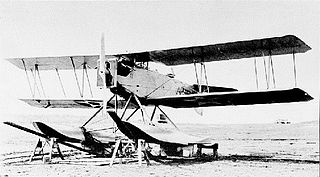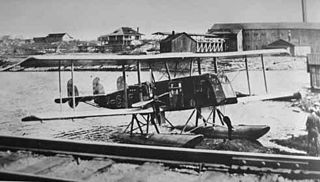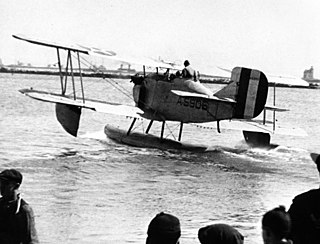| Elias | |
|---|---|
 | |
| EM-1 | |
| Role | Utility biplane |
| Manufacturer | Elias |
| Introduction | 1922 |
| Primary users | United States Navy United States Marine Corps |
| Number built | 7 |
The Elias EM was a 1920s American general-purpose and marine expeditionary biplane built by Elias.
| Elias | |
|---|---|
 | |
| EM-1 | |
| Role | Utility biplane |
| Manufacturer | Elias |
| Introduction | 1922 |
| Primary users | United States Navy United States Marine Corps |
| Number built | 7 |
The Elias EM was a 1920s American general-purpose and marine expeditionary biplane built by Elias.
The company designed the Elias EM-1 to meet a United States Marine Corps requirement for a multirole marine expeditionary aircraft. It was required to operate on either floats or wheels. The EM-1 was a tandem two-seat unequal-span biplane powered by a 300 hp (224 kW) Wright-Hispano H engine. The prototype was modified with equal-span wings and delivered to the Marine Corps in 1922. Six production aircraft were built (designated EM-2) having equal-span wings, being powered by 400 hp (298 kW) Liberty 12 inline engines. [1]
One production aircraft was delivered to the United States Marine Corps and five to the United States Navy. One of the Navy aircraft was modified as an observation aircraft and redesignated EO-1.
Data from The Illustrated Encyclopedia of Aircraft
General characteristics
Performance
Armament
Related lists

The Douglas DT bomber was the Douglas Aircraft Company's first military contract, forging a link between the company and the United States Navy. Navy Contract No. 53305 of April 1, 1921, required only 18 pages to set out the specifications that resulted in the purchase of three DT folding-wing aircraft.

The Boeing Model 15 was a United States single-seat open-cockpit biplane fighter aircraft of the 1920s, manufactured by the Boeing company. The Model 15 saw service with the United States Army Air Service and with the United States Navy as a carrier-based fighter.

The Curtiss Model N was a military trainer used primarily by the United States Navy during World War I.

The Vought O2U Corsair was a 1920s biplane scout and observation aircraft. Made by Vought Corporation, the O2U was ordered by the United States Navy (USN) in 1927. Powered by a 400 hp (298 kW) Pratt & Whitney R-1340 Wasp engine, it incorporated a steel-tube fuselage structure and a wood wing structure with fabric covering. Many were seaplanes or amphibians.

The Aeromarine AS was a seaplane fighter aircraft evaluated by the US Navy in the early 1920s.

The Fokker S.III was a biplane trainer aircraft of the 1920s. It was of conventional configuration, seating the pilot and instructor in tandem, open cockpits. The single-baywings were staggered and of unequal span.

The Curtiss Model E was an early aircraft developed by Glenn Curtiss in the United States in 1911.

The Curtiss Eagle was an airliner produced in small numbers in the United States shortly after World War I. The aircraft was a conventional biplane with three-bay, unstaggered wings of equal span. The fuselage was a very advanced design for its day, incorporating careful streamlining of its monocoque structure, and offering the crew as well as the passengers a fully enclosed cabin. The Eagle is sometimes named as the first American tri-motor aircraft; however Curtiss' own Model H flying boat flew with three engines for a time in 1914 before being converted back to twin-engine configuration.

The Curtiss Model R was a utility aircraft produced for the United States Army and Navy during World War I. It was a conventional, two-bay biplane with slightly staggered wings of unequal span. The aircraft was provided with two open cockpits in tandem and fixed tailskid undercarriage, but many were built for the Navy with twin floats replacing the wheels. During the course of the war, Model Rs were used for general liaison and communication duties, as well for observation, training, and as air ambulances. In practice, the Curtiss powerplants supplied with these aircraft proved insufficient and were mostly replaced with Liberty engines. The Navy's Model R-3 floatplane had extended-span, three-bay wings, and was intended for use as a torpedo bomber. Some of these were later fitted with wheeled undercarriage and transferred to the Army as bombers under the designation Model R-9.
The Pomilio BVL-12 was an American experimental single-engine biplane bomber built by the United States Army Engineering Division to the design of Ottorino Pomilio for the United States Army Air Corps after World War I.

The Dayton-Wright FP.2 was a forestry patrol aircraft developed in the United States in the early 1920s for use by the Canadian Forest Service. It was a twin-engine two-bay biplane with equal-span, unstaggered wings that were designed to be interchangeable between top and bottom. Initially designed with the props in a pusher position, the engines were remounted in tractor position before the aircraft went into service. The cabin was fully enclosed and seated four, with the single pilot in an extensively glazed nose. The empennage had triple fins, and the landing gear consisted of twin pontoons. Only a single example was built. While in service the aircraft was modified with larger side windows, and controls for a second pilot.

The Martin MB-1 was an American large biplane bomber designed and built by the Glenn L. Martin Company for the United States Army Air Service in 1918. It was the first purpose-built bomber produced by the United States.

The Martin T3M was an American torpedo bomber of the 1920s. A single-engined three-seat biplane, it became a standard torpedo bomber of the U.S. Navy, operating from both land bases and from aircraft carriers from 1926 to 1932.

The Martin T4M was an American torpedo bomber of the 1920s. A development by the Glenn L. Martin Company of their earlier Martin T3M, and, like it a single-engined biplane, the T4M served as the standard torpedo bomber aboard the aircraft carriers of the United States Navy through much of the 1930s.

The Naval Aircraft Factory TG were a series of prototype seaplanes for gunnery training designed and built by the United States Navy's Naval Aircraft Factory.
The Borel-Odier Bo-T was a French twin-engined float biplane designed by Borel but built by Antoine Odier for the French Navy.

The Waco E series is a small family of American-built cabin biplanes built between 1939 and 1942, which differed primarily by engine installation.
The Orneco IL-1 was an American two-seat liaison biplane built for the United States Army by the Ordnance Engineering Corporation (Orenco). The Model E-2 was a conventional biplane powered by a 400 hp (298 kW) Liberty 12 engine and designated IL-1 by the Army. First flown in 1919, two aircraft were built and evaluated by the Army at McCook Field as P-147 and P-168, but the type did not enter production.
The L-W-F T-3 was an American eight-passenger transport biplane built for the United States Army Air Service (USAAS) by the L-W-F Engineering Company Inc.. Designated T-3 by the Army it was a conventional biplane powered by a 400 hp (298 kW) Liberty L-12A engine. It had an open cockpit for the pilot and an enclosed cabin for eight passengers. The sole T-3 was delivered to the USAAS in 1923, re-designated XT-3 and used as an engine test bed. A further nine T-3s on order were cancelled and not built.

G Elias & Brother was and American manufacturer of cabinets and aircraft based in Buffalo, New York in the 1920s. A.G. Elias sat on the Manufacturers Aircraft Association's board of directors along with President Frank H. Russell, VP Glenn L. Martin, Charles L. Laurence, Chance M. Vought, S.S. Bradley, George P. Tidmarsh, and Donald Douglas. E.J Elias promoted the construction of a Buffalo municipal airport to aid the local fledgling airplane industry of five aviation companies constructing airplanes and airplane parts. From 1920 to 1925, Elias company's chief engineer, David Earle Dunlap (1896-1957), designed the Elias EM-2 Expeditionary planes. He designed the NBS-3 bomber fuselage and the Elias M-1 Mail plane. Dunlap's Elias TA-1 design was the first United States Army Air Corps Trainer to have a radial engine. After tests a McCook Field, the Army Air Corps selected other manufacturers over the Elias bomber and trainer. The company designed the Elias EM-1 to meet requirements for a multirole amphibian marine expeditionary aircraft. Elias delivered six production Elias EM-2 aircraft with Liberty engines to the United States Navy in 1922.
| Wikimedia Commons has media related to Elias EM . |